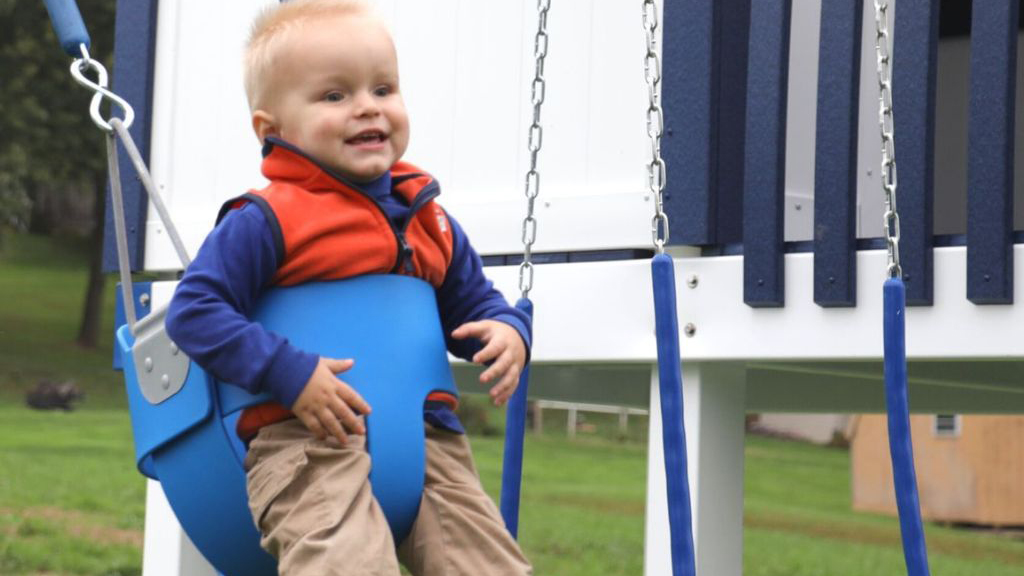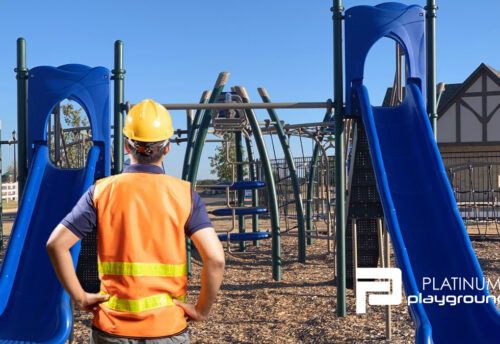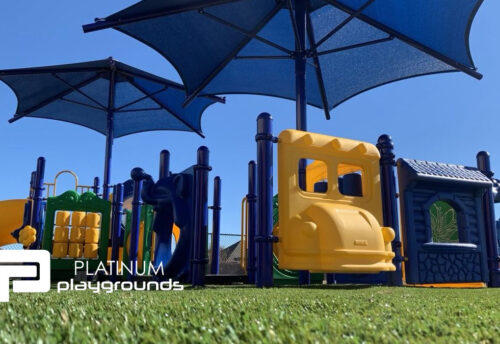Top Playground Safety Features to Consider: Keeping Fun Safe for Everyone
When it comes to playgrounds, fun and playground safety should go hand in hand. Because let’s face it: no one wants to relive the days of sharp metal slides or dizzyingly high monkey bars from the ’80s. Today, playgrounds are designed with safety in mind. Play areas are packed with thoughtful features that minimize the risk of injury while maximizing the joy of play.
Find more “Tips, Regulations, and Best Practices for Peace of Mind“ to ensure playground safety.
Whether you’re a community leader, a business owner, or a parent, understanding the built-in safety features can help you choose the right playground for your space. Let’s explore some of the top safety features to keep in mind—from rounded edges to perfect fall zones—because happy parents mean happy kids, and happy kids mean… well, a lot more peace for everyone!
Ensuring Playground Safety with Rounded Edges: Goodbye to Sharp Corners
It’s surprising how much of a difference a little curve can make. Rounded edges are now a must-have feature in modern playground equipment, and they’re everywhere: on slides, climbing frames, platforms, and even handlebars.
Why Rounded Edges Matter
- Reduces Injury Risks: Rounded edges mean fewer sharp corners for kids to run into, lean over, or bump into during play. Fewer sharp edges means fewer band-aids and a lot fewer tears.
- Smoothens Play: Rounded equipment is generally more comfortable to grip, lean on, or even occasionally trip over (hey, it happens).
- Lasting Durability: Rounded edges wear down more slowly, making them safer in the long term—no rough edges from wear and tear.
When selecting playground equipment, make sure rounded edges are a standard feature. Not only will it make the playground safer, but it’ll also reduce your maintenance concerns.
Playground Safety Fall Zones: Giving Kids (and Parents) a Safer Landing
Let’s be real: kids fall. They fall while running, climbing, jumping, and sometimes even while just standing still. Playground designers know this and have designed playgrounds with strategic “fall zones” in mind. Fall zones make sure kids have a softer landing wherever they’re likely to take a tumble.
What Are Fall Zones?
A fall zone is an area around playground equipment designed to cushion falls and prevent injury. These zones include surfaces like soft rubber, mulch, or engineered wood fiber that absorb shock, reducing the impact of a fall.
Key Fall Zone Playground Safety Features
- Appropriate Surfacing: Whether it’s rubber mats or wood chips, fall zones need a soft material that meets the height standards set by safety organizations. For instance, the Consumer Product Safety Commission (CPSC) recommends materials like sand, mulch, or engineered wood fiber.
- Strategic Layout: Fall zones are designed to extend a minimum distance from each piece of equipment. For taller play structures, fall zones are bigger, allowing space for safer landings.
- Durability and Maintenance: Materials should be able to withstand the elements and regular use. Surfaces like poured-in-place rubber and rubber tiles are long-lasting and easy to maintain, making them a smart choice for public spaces.
Fall zones don’t just prevent injury—they’re a critical feature that can give parents peace of mind and reduce the chances of frequent repairs. That’s a win for both parents and playground managers!
Learn more about “Choosing Safety Surfacing for Commercial Playgrounds“.
Visibility: Keeping an Eye on Playground Safety
Visibility is a crucial safety feature in playground design, making it easy for parents and caregivers to keep an eye on children from every angle. It might seem simple, but this feature can significantly reduce the risk of accidents.
The Importance of Visibility
- Prevents Hidden Hazards: Clear sightlines mean kids are less likely to get into trouble behind large structures or in hidden spaces.
- Encourages Safer Play: When kids know they’re being watched (even if they’re unaware), they tend to play safer.
- Enables Quick Intervention: In case of an accident, clear sightlines help adults respond quickly, especially when a child is injured or needs help.
Design Features That Improve Visibility
Playground Safety designers use a few clever tricks to keep lines of sight open:
- Low Walls and Clear Barriers: Where barriers are needed, transparent materials like acrylic or low walls let parents see through while keeping kids safe.
- Strategic Equipment Placement: Designers often avoid placing tall structures near entrances or exits, making it easier to monitor kids entering and exiting the play area.
- Minimizing Obstructions: Open layouts, lower bushes, and wide pathways reduce hiding spots and allow clear views from all angles.
These elements make it easy for parents, teachers, and caregivers to keep a close watch on children, ensuring playtime stays safe.
Anti-Entrapment Openings: Preventing Stuck Situations
Ah, the dreaded entrapment situations. No one wants to be the kid who got their head or arm stuck in playground equipment (or the adult who has to awkwardly help them out). Anti-entrapment openings are a fantastic safety feature designed to prevent these kinds of incidents.
What’s an Anti-Entrapment Opening?
Entrapment-prevention design ensures that all openings are large enough that kids can easily fit through without getting stuck. It also ensures that gaps in playground equipment are too small for a child to squeeze through.
Key Playground Safety Benefits
- Prevents Head and Limb Entrapment: Safety regulations require that openings be either smaller than 3.5 inches or larger than 9 inches to avoid trapping a child’s head or limbs.
- Increases Confidence: Knowing there’s no risk of entrapment allows kids to play freely without fear of getting caught.
- Meets Standards: Playground equipment manufacturers follow specific guidelines (like those set by ASTM) to ensure equipment is safe for all ages.
Anti-entrapment features offer peace of mind for everyone, making it one of the must-have features for any commercial playground.
Don’t forget the “Importance of Regular Playground Inspections“.
High-Quality Materials and Finishes: Built for Playground Safety and Durability
The materials used in playground equipment can make all the difference. High-quality materials improve not only the look of a playground but also its durability and safety.
What to Look for in Materials
- UV-Resistant Coatings: Playground equipment is often exposed to sunlight, which can weaken materials over time. UV-resistant coatings prevent fading and degradation, keeping the equipment safe and looking good for years.
- Rust and Weather Resistance: Metal playground equipment should have a rust-resistant finish, while plastic should be resistant to cracking. Rain or shine, the equipment should be ready for play.
- Non-Toxic Materials: Look for non-toxic finishes, especially on elements like plastic or metal that kids might touch or mouth.
When choosing playground equipment, high-quality, weather-resistant materials are always worth the investment. High-quality materials reduce maintenance costs, ensure safety, and keep your playground looking as inviting as ever.
Safe, Fun, and Ready for Play!

When it comes to playground safety, every detail matters. From rounded edges to carefully designed fall zones, Platinum Playgrounds knows how each feature plays a role in creating a safer, happier play space. And while safety features are there to protect kids, they also create peace of mind for adults—making every trip to the playground a little less nerve-wracking.
So, whether you’re designing a playground from scratch or updating an existing one, remember to keep safety at the forefront. Contact Platinum Playgrounds for equipment with top safety features built in, so you can create a fun and safe environment where kids are free to play, laugh, and yes, sometimes fall—but always in a safer way.


